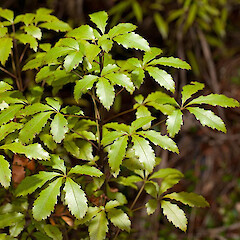Pseudopanax discolor
Synonyms
Panax discolor Kirk
Family
Araliaceae
Flora category
Vascular – Native
Endemic taxon
Yes
Endemic genus
No
Endemic family
No
Structural class
Trees & Shrubs - Dicotyledons
NVS code
The National Vegetation Survey (NVS) Databank is a physical archive and electronic databank containing records of over 94,000 vegetation survey plots - including data from over 19,000 permanent plots. NVS maintains a standard set of species code abbreviations that correspond to standard scientific plant names from the Ngä Tipu o Aotearoa - New Zealand Plants database.
PSEDIS
Chromosome number
2n = 48
Current conservation status
The conservation status of all known New Zealand vascular plant taxa at the rank of species and below were reassessed in 2017 using the New Zealand Threat Classification System (NZTCS) – more information about this can be found on the NZTCS website. This report includes a statistical summary and brief notes on changes since 2012 and replaces all previous NZTCS lists for vascular plants.
Please note, threat classifications are often suggested by authors when publications fall between NZTCS assessment periods – an interim threat classification status has not been assessed by the NZTCS panel.
- Conservation status of New Zealand indigenous vascular plants, 2017 . 2018. Peter J. de Lange, Jeremy R. Rolfe, John W. Barkla, Shannel P. Courtney, Paul D. Champion, Leon R. Perrie, Sarah M. Beadel, Kerry A. Ford, Ilse Breitwieser, Ines Schönberger, Rowan Hindmarsh-Walls, Peter B. Heenan and Kate Ladley. Department of Conservation. Source: NZTCS and licensed by DOC for reuse under the Creative Commons Attribution 4.0 International licence.
2017 | Not Threatened
Previous conservation statuses
2012 | Not Threatened
2009 | Not Threatened
2004 | Not Threatened
Brief description
Shrubby small tree with toothed leaves in groups of three at the end of long stems
Distribution
Endemic. North Island. Northland to upper Waikato region.
Habitat
Coastal and lowland forest and shrubland. Sealevel to c. 750 m a.s.l. A common component of the sites it inhabits
Detailed description
Shrubby much-branched small tree to 5 m tall, branchlets fleshy, brittle, bark pale brown, lenticels prominent. Leaves alternate; Petioles 2-8 cm long; leaflets (1-)3(-5), palmate, thinly coriaceous, dark green to bronze or yellowish green above, paler purplish green below, obovate- to elliptic-cuneate, coarsely and sharply serrate, midrib and lateral veins prominent, darker. Terminal leaflet 4-8 x 1.5-2.5 cm, on short (c. 5 mm) petiolule, lateral leaflets sessile. Inflorescence a diffuse terminal umbel; staminate (male) with 4-10 rays, 3-8 cm long, racemosely arranged; pistillate (female) with rays 2-5 cm long, umbellules irregular, 2-6 flowered. Ovary 5-loculed, each containing 1 ovule (some aborted); style branches 5, connate, tips free. Fruit fleshy, oblong, 6.5 mm long, style branches retained on an apical disc, dark purple when ripe. Seeds 4-5 per fruit, easily broadly ovate, grooved, 4.5-5.5 mm long.
Similar taxa
Only usually confused with Pseudopanax arboreus which usually has 5 leaflets. Psudopanax colensoi var. ternata also has three leaflets but these are larger and thicker.
Flowering
November-February
Flower colours
Green
Fruiting
November-February
Etymology
pseudopanax: False cure
discolor: Two colours or of different colours; from the latin dis and color; different colours of the leaf surfaces
Attribution
Description adapted from Allan (1961).
References and further reading
Allan, H.H. 1961. Flora of NZ, Vol. I. Government Printer, Wellington
Webb, C.J. & Simpson, M.J.A. 2001. Seeds of NZ gymnosperms and dicotyledons. Manuka Press, Christchurch.






